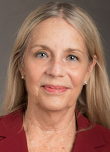Trial Navigators: The Key To Increased Patient Participation In Clinical Trials
By Erika Brown, president, CEO, and co-founder, Paltown Development Foundation

The appallingly low rates of patient participation in cancer clinical trials, especially in the community setting, is no secret.1,2 The fact is that 98 percent% of our patient population isn’t aware of available trials, doesn’t know how to apply, or is under too much financial and emotional strain, etc. to even consider joining a trial. The blame for this rightfully falls on the proverbial shoulders of the main stakeholders: the biopharmaceutical industry, healthcare institutions, government, and — yes — patient support groups. The fact of the matter is that there could be a very simple answer to this big problem: patients trained to be clinical trial navigators.3
My premise today is that the most successful trial navigators are other patients and caregivers. Those of us with actual experience are the most important stakeholders. We are the ones who have a vested interest in seeing our loved one survive; we are the ones who wish to beat our own cancer. And we patients love being able to assist other patients, much as we would help any family member. We have learned that one of our most healthy personal practices is to serve other patients.
Why is it so important to have patients/caregivers in this guiding role? Because patients trust our people: our “brothers and sisters” who are experiencing the same disease. The only person who truly gets it for us is another survivor; the surviving patient has done something that we want to emulate so that we can recover. That patient has walked in our shoes and knows how we feel. That caregiver is going to understand our fears, and he/she will relate to our objections. Later, I will introduce you to Tom Marsilje, a patient who is the model for this idea. Tom, a drug discovery scientist, was willing to share his knowledge with those of us who reached out to him. Patients and caregivers trusted and relied deeply upon his authentic direction and guidance.
It Takes A Village: The Colontown Model
As a patient myself, I founded Colontown, a patient-driven, online global colorectal cancer community. What makes Colontown unique is that our community hosts nearly 150 separate, intimate, and targeted “neighborhood” discussions – each with a focus on a specific aspect of living with and being treated for varying stages of colorectal cancer (CRC). Our goal is to empower patients to find their own pathway to recovery from the cancer diagnosis.
Even more unique for a patient community: Nine of those neighborhoods are focused on learning about clinical trials for CRC. For example, Tom’s MSS Clinic – A Colontown Original Experience, is made up of more than 1,200 patients and caregivers who are discussing — and in many cases participating in – clinical trials. (About 95 percent of our CRC population’s tumors are “microsatellite status stable,” or MSS.) Here, people are being guided in the direction of scientific learning, applying their learning to their own cases, and sharing their rationales and treatment strategies with others. Word gets around fast when scans are stable or tumors shrink. Posts about progression quickly transform to strategizing together for the next steps. Breakthroughs in pre-clinical studies and utility of liquid biopsies are discussed at length, as well as frustrations about the current state of clinical trials. Colontown is a snapshot of CRC cancer patients world-wide who are actually seeing clinical trials as a way to deliver tomorrow’s treatments to them today.
Our mission for Colontown is to attract, educate, and empower patients by helping them understand the science of colorectal cancer treatment. The point of the sudden immersion into science is to prepare each patient with a realistic “landscape view” — akin to the helpful GPS map display in today’s cars — of what comes next in their treatment future. It is in our own best interest that we patients become proactive participants in our treatment decisions and journeys. At Colontown, we help our patients to be knowledgeable choice-makers in our treatment decisions, and we have learned — to our delight — that our best CRC oncologists share that very same goal for us.
Tom’s Story
Tom Marsilje, Ph.D., is the namesake for all of our Colontown clinical trials discussions and was our first patient/scientist/educator/guide. On the very day that his own cancer drug discovery for lung cancer was approved by the FDA, Tom had his first colonoscopy. On that day of his discovery success, he also learned that he had advanced colon cancer. He told me later that that was the day he decided to dedicate the rest of his life to helping others even more directly, while at the same time seeking his own CRC clinical trial. Tom was dedicated to helping other patients understand the value of the clinical trial in their own recovery strategies, while also explaining the rationale that supported each trial.
Tom was the scientist/science teacher that we could understand and for whom we had so much love and respect.
Tom’s own metaphor for the winning cancer treatment experience was simple and powerful: We need to visualize ourselves as a jet plane at the “top of our runway path” when we commence our cancer treatment journey. Our strategy must be that we have our imaginary “fuel tanks” filled with every bit of current information. Doing this informs our first, important treatment decision up front and, thusly, we equip ourselves to be able to go full-throttle down the treatment “runway” and — hopefully — lift off into renewed life.
But we also need to have additional “planes on the runway” — the next treatment options lined up, based on scientific information and trial data but crucially informed by the experiences and insights of fellow patients. How do we find trials that will work for our own situation? How do we make sense of inclusion and exclusion criteria and avoid imprudent decisions that could limit future options? What are the nuts and bolts of actually getting enrolled in a trial? Tom’s work was a model for the vital role of patients helping other patients navigate the daunting clinical trial landscape.
Because of Tom’s work helping patients, Colontown has been put on the clinical trials “map.” Because Tom was so active in our daily lives, patients who otherwise never would have considered seeking a clinical trial have entered the clinical trial process. The notion of a knowledgeable patient navigator or guide has taken root in our community. We encourage all patients to join our clinical trial neighborhoods, even if they are responding to standard treatments, in order to familiarize themselves with the scientific jargon and processes of trials. And our ongoing efforts have garnered media attention well beyond Colontown.4
Sadly, Tom was not able to qualify for a trial for himself. But he helped others to understand the scientific rationale and efficacy of trials that he felt would have therapeutic merit for other patients. Tom taught us the importance of achieving medical literacy sooner rather than later for our own survival. He would be pleased to know that we have an emerging group of patients and caregivers who are now performing the same function that he did, with equal care and concern for helping others. The people he mentored have themselves become mentor/navigators (informally), and they are passing along what they know to others. Each day in Colontown we witness newer patients “getting it,” and asking what they can do to learn more science and give back to their community.
Biopharma’s Seat At The Table
You might now be asking how the biopharma industry might participate in these efforts. One practical way is to financially support the ongoing promotion of and scientific training of our growing list of Tom’s Trials Trainers — patients and caregivers who are actively engaged currently in our Tom’s Trials (and other) neighborhood discussions in Colontown.
You could also invite us to meet with you and your scientists. If you have folks who could help us train our patients in workshop settings, we would welcome that. We could use your scientific knowledge to select and properly train our patients to provide this potentially life-saving service.
Our initial class of patient/caregiver trainees — some of whom were directly mentored by Tom himself before his unfortunate death from CRC — are engaged now in various efforts to build out this model. Continuing, we will pursue the following:
- Building out the database of interested patients/caregivers
- Working with scientifically trained trial navigators to create and deliver the training courses
- Developing funding from industry for training and compensation of our new cadre of patient/navigators
- Creating a method to evaluate the effectiveness of the training (by looking at increased trial participation, dissemination of trial associated information, improved trial-related education in the patient community, etc.)
- Looking for ways to integrate Tom’s Trials Trainers in cancer centers and community clinics where they can provide trial assistance and increase awareness of the availability of clinical trials.
Tom’s legacy is that of a person who was dedicated to the positive outcomes that might be achieved with clinical trials for patients. Currently in Colontown, we support approximately 4,500 engaged patient and caregiver citizens, 1,500 of whom are also actively involved in learning about appropriate clinical trials. Our proactive population is now making a huge impression on their treating physicians and, as a consequence, many of the leading oncologists are helping to guide these scientific discussions. And our growing ranks of powerful, enabled, proactive, and purposeful patients provide ample proof that the clinical trial navigator model is exactly right for increasing patient engagement in clinical trials and improving the cancer recovery process.
References:
- https://www.pbs.org/newshour/show/cancer-treatment-progress-stunted-by-lack-of-volunteers
- https://www.cancernetwork.com/oncology-journal/inadequate-awareness-and-participation-cancer-clinical-trials-community-oncology-setting
- https://www.pbs.org/newshour/show/cancer-treatment-progress-stunted-by-lack-of-volunteers
- https://colontown.org/colontown-in-the-news/
About The Author:
 Erika Hanson Brown, president, CEO , and cofounder of Paltown Development Foundation, had a long and healthy career as a corporate executive search professional in the consumer packaged goods and telecommunications industries until — at age 58 — she was diagnosed with late-stage colorectal cancer. Once her treatment was completed, she refocused her professional energies on the undeveloped niche of disease-specific patient empowerment communities, founding the patient-led community Colontown. Colontown features deeply engaged, experience-specific, secret support groups that are exclusively dedicated to colorectal cancer patients and family members. Brown is honored to serve on the NIH’s Colon Task Force and to be a CRC Dream Team member for Stand Up To Cancer.
Erika Hanson Brown, president, CEO , and cofounder of Paltown Development Foundation, had a long and healthy career as a corporate executive search professional in the consumer packaged goods and telecommunications industries until — at age 58 — she was diagnosed with late-stage colorectal cancer. Once her treatment was completed, she refocused her professional energies on the undeveloped niche of disease-specific patient empowerment communities, founding the patient-led community Colontown. Colontown features deeply engaged, experience-specific, secret support groups that are exclusively dedicated to colorectal cancer patients and family members. Brown is honored to serve on the NIH’s Colon Task Force and to be a CRC Dream Team member for Stand Up To Cancer.
